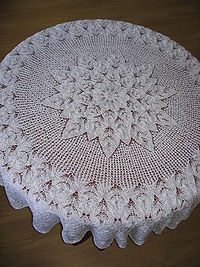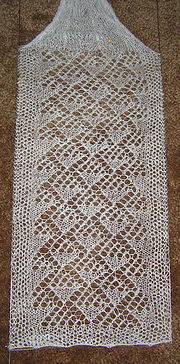
Lace knitting
Encyclopedia

Knitting
Knitting is a method by which thread or yarn may be turned into cloth or other fine crafts. Knitted fabric consists of consecutive rows of loops, called stitches. As each row progresses, a new loop is pulled through an existing loop. The active stitches are held on a needle until another loop can...
characterized by stable "holes" in the fabric
Textile
A textile or cloth is a flexible woven material consisting of a network of natural or artificial fibres often referred to as thread or yarn. Yarn is produced by spinning raw fibres of wool, flax, cotton, or other material to produce long strands...
arranged with consideration of aesthetic value. Lace
Lace
Lace is an openwork fabric, patterned with open holes in the work, made by machine or by hand. The holes can be formed via removal of threads or cloth from a previously woven fabric, but more often open spaces are created as part of the lace fabric. Lace-making is an ancient craft. True lace was...
is sometimes considered the pinnacle of knitting
Knitting
Knitting is a method by which thread or yarn may be turned into cloth or other fine crafts. Knitted fabric consists of consecutive rows of loops, called stitches. As each row progresses, a new loop is pulled through an existing loop. The active stitches are held on a needle until another loop can...
, because of its complexity and because woven fabrics
Woven
A woven is a cloth formed by weaving. It only stretches in the bias directions , unless the threads are elastic. Woven cloth usually frays at the edges, unless measures are taken to counter this, such as the use of pinking shears or hemming.Woven fabrics are worked on a loom and made of many...
cannot easily be made to have holes. Some consider that "true" knitted lace has pattern stitches on both the right and wrong sides, and that knitting with pattern stitches on only one side of the fabric, so that holes are separated by at least two threads, is technically not lace, but "lacy knitting", although this has no historical basis.
Eyelet patterns are those in which the holes make up only a small fraction of the fabric and are isolated into clusters (e.g., little rosette
Rosette (design)
A rosette is a round, stylized flower design, used extensively in sculptural objects from antiquity. Appearing in Mesopotamia and used to decorate the funeral stele in Ancient Greece...
s of one hole surrounded by others in a hexagon).
At the other extreme, some knitted lace is almost all holes, e.g., faggoting. Famous examples include the wedding ring shawl
Orenburg shawl
The Orenburg Shawl is one of the classic symbols of Russian handicraft, along with along with Tula Samovar, Matrioshka, Khohloma painting, Gzhel, Palekh, Vologda lace, Dymkovo toys, Rostov finift , and Ural malachite...
of Shetland knitting, a shawl so fine that it could be drawn through a wedding ring. Shetland knitted lace became extremely popular in Victorian England when Queen Victoria became a Shetland lace enthusiast. From there, knitting patterns for the shawls were printed in English women's magazines where they were copied in Iceland with single ply wool.
Knitted lace with no bound-off edges is extremely elastic, deforming easily to fit whatever it is draped on. As a consequence, knitted lace garments
Clothing
Clothing refers to any covering for the human body that is worn. The wearing of clothing is exclusively a human characteristic and is a feature of nearly all human societies...
must be blocked
Blocking (knitting)
In knitting, crochet and other textile arts, blocking is a final stage of handmade textile production that adjusts the shape of the finished piece. Not all pieces need blocking, however blocking is standard for lace work, and is not uncommon in sweaters, socks, and other solid projects...
or "dressed" before use, and tend to stretch over time.
Some lace is distinguished by its shape and method. Faroese lace shawls
Faroese lace shawls
A Faroese shawl is a traditional piece of clothing from the Faroe Islands. The most distinguishing characteristic of Faroese shawls is the center back gusset shaping. Each shawl consists of two triangular side panels, a trapezoid-shaped back gusset, an edge treatment, and usually shoulder shaping...
are knit bottom up with center back gusset shaping unlike a more common neck down, triangular shawl.
Technique

Yarn over
In knitting, a yarn over is technique in which the yarn is passed over the right-hand knitting needle. In general, the new loop is knitted on the next row, either by itself or together with an adjacent stitch . The yarn-over may also be dropped on the next row, producing a longer stretch of yarn...
stitch with a nearby (usually adjacent) decrease
Decrease (knitting)
A decrease in knitting is a reduction in the number of stitches, usually accomplished by suspending the stitch to be decreased from another existing stitch or by knitting it together with another stitch.-Methods of Single Decreasing :...
. If the decrease precedes the yarn over, it typically slants right as seen from the right side (e.g., k2tog, not k2tog tbl; see knitting abbreviations
Knitting abbreviations
Knitting abbreviations are often used for brevity in describing knitting patterns.Knitting abbreviations can be grouped by what they describe:* knit 2 together* side of work* type of stitch* scope of stitch* orientation of stitch...
). If the decrease follows the yarn over,
it typically slants left as seen from the right side (e.g., k2tog tbl or ssk, not k2tog). These slants pull the fabric away from the yarn over, opening up the hole.
Pairing a yarn over with a decrease
Decrease (knitting)
A decrease in knitting is a reduction in the number of stitches, usually accomplished by suspending the stitch to be decreased from another existing stitch or by knitting it together with another stitch.-Methods of Single Decreasing :...
keeps the stitch count constant. Many beautiful patterns separate the yarn over and decrease stitches, e.g., k2tog, k5, yo. Separating the yarn over from its decrease "tilts" all the intervening stitches towards the decrease. The tilt may form part of the design, e.g., mimicking the veins in a leaf.
There are few constraints on positioning the holes, so practically any picture or pattern can be outlined with holes; common motifs include leaves, rosettes, ferns and flowers. To design a simple lace motif, a knitter
Knitting
Knitting is a method by which thread or yarn may be turned into cloth or other fine crafts. Knitted fabric consists of consecutive rows of loops, called stitches. As each row progresses, a new loop is pulled through an existing loop. The active stitches are held on a needle until another loop can...
can draw its lines on a piece of knitting graph paper; right-slanting lines should be produced with "k2tog, yo" stitch-pairs (as seen on the right side) whereas left-slanting lines should be produced with "yo, k2tog tbl" (or, equivalently, "yo, ssk" or "yo, skp") stitch pairs (again, as seen on the right side). More sophisticated patterns will change the grain of the fabric to help the design, by separating the yarn overs and decrease
Decrease (knitting)
A decrease in knitting is a reduction in the number of stitches, usually accomplished by suspending the stitch to be decreased from another existing stitch or by knitting it together with another stitch.-Methods of Single Decreasing :...
s.
It is common for lace knitters to insert a "lifeline", a strand of contrasting yarn threaded through stitches on the needle, at the end of every pattern repeat or after a certain number of rows. This allows the knitter to rip out a controlled number of rows if a mistake is discovered.
Simple examples
A horizontal row of holes can be produced by the pattern: *k3, k2tog, yo, k3*.A pair of vertical columns can be produced by stacking the pattern: (k, k2tog, yo, k, yo, k2tog tbl, k)
on the right side. Here the flanking decreases slant outwards away from the central stitch. For a thicker
central column, one can move the decreases so that they slant inwards: (k, yo, dec 2 symmetrically, yo, k).
For making the same pattern on the wrong side, the converse stitch patterns are:
(p, p2tog, yo, p, yo, p2tog tbl, p) and (p, yo, dec 2 symmetrically, yo, p), respectively.
A diagonal row of holes can be made by shifting the (yo, dec) every row or every other row, e.g.,
- Row 1: k, k2tog, yo, k5
- Row 3: k3, k2tog, yo, k3
- Row 5: k5, k2tog, yo, k1
History and comparison to other laces
Lace knitting is generally not as fine as other forms of lace, such asneedle lace
Needle lace
Needle lace is a type of lace created using a needle and thread to stitch up hundreds of small stitches to form the lace itself....
or bobbin lace
Bobbin lace
Bobbin lace is a lace textile made by braiding and twisting lengths of thread, which are wound on bobbins to manage them. As the work progresses, the weaving is held in place with pins set in a lace pillow, the placement of the pins usually determined by a pattern or pricking pinned on the...
. However, it is better suited for garments, being softer and much faster to produce.

